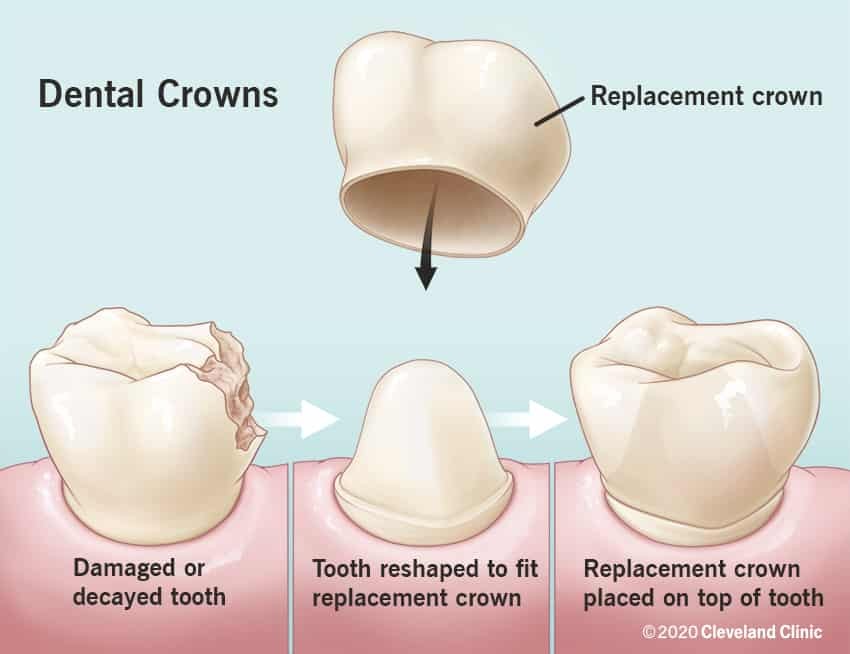
Contents
- 1 Dental Crowns
- 1.0.1 Types of dental crowns
- 1.0.2 Other relevant terms
- 1.0.3 When is a dental crown needed?
- 1.0.4 Procedure for getting a dental crown
- 1.0.5 Pain associated with getting a dental crown
- 1.0.6 Special considerations for getting a dental crown during pregnancy
- 1.0.7 How long do dental crowns last?
- 1.0.8 Problems that may occur after getting a dental crown
- 1.0.9 Cost of crowns
Dental Crowns
The anatomy of a tooth can be divided into two parts — the root and the crown.
- In a person with healthy gums and bones, the root of the tooth is covered by the gums and bone.
- The crown is the visible part of the tooth in the mouth, above the gum line on lower teeth, and below the gum line on upper teeth.
A cemented restoration that partially or completely covers the outside of the tooth is a dental crown or cap.
Types of dental crowns
Crowns can be made of a gold alloy, another metal alloy, stainless steel, all-porcelain/all-ceramic, composite resin, zirconia, or porcelain on the outside fused to metal or zirconia on the inside.
In some cases, ceramic crowns can be made with CAD/CAM technology by milling the crowns out of blocks of porcelain in the dental office, without the need for temporaries or a dental laboratory. There are advantages and disadvantages to all types of dental crowns.
- Stainless steel crowns are preformed crowns used to cover baby teeth for children.
- Gold dental crowns have traditionally been the most durable and require less tooth removal.
- Porcelain crowns have aesthetic advantages, while newer types of ceramic crowns are more durable.
Other relevant terms
- Crown preparation: This is the design of the tooth after it has been shaved down to allow room for a crown. Preparation depends on the crown’s material, previous fillings, fractures, and root canal therapy. There must be enough tooth structure for the crown to adhere to.
- Margin: This is the edge of the crown that meets the prepared surface of the tooth. It needs to be smooth with no gaps or ledges.
- Cusps: These are the raised or pointy parts of a tooth used for tearing and chewing food. When a cusp is damaged, the tooth needs a crown to prevent further damage.
- Partial crown/onlay: This is a restoration that covers some, but not all, of the cusps of a tooth. It is a conservative measure to preserve as much tooth structure as possible.
- Dental veneer: Porcelain veneers are partial crowns that cover only the front and biting edges of teeth, enhancing their appearance. They can be placed on crooked teeth for "instant orthodontics."
- Temporary/provisional: This is a temporary crown placed on the tooth while waiting for the final crown to be made. It shouldn’t be left on for long and is sometimes used to alleviate pain or symptoms.
QUESTION
When is a dental crown needed?
There are various situations that require a dental crown:
- Large filling: When a tooth has a cavity or fracture that involves half the width of the tooth or more, it needs to be covered with a crown. This is because the remaining tooth around the large filling is weak and prone to fracture.
- Root canal: A tooth that has had a root canal almost always needs to be restored with a crown to prevent it from fracturing.
- Cracked tooth syndrome: A crown can eliminate pain caused by fractures inside a tooth that result in discomfort when chewing.
- Broken cusps: When cusps break off due to trauma or large fillings, they need to be completely covered to prevent further fracturing.
- Excessive wear of teeth: Grinding or acid erosion can cause teeth to wear away, and crowns can restore them to their normal size.
- Undesirable appearance of teeth: Crowns and veneers can enhance the appearance of teeth that have color, shape, or space issues.
- Other: Crowns can be used to restore spaces left by missing teeth or provide stability to loose teeth when placed on multiple teeth.
Procedure for getting a dental crown
The dental crown procedure involves numbing the tooth with local anesthesia. If the tooth has been fractured or had a root canal, it will first need a buildup. Then the tooth is shaved down, an impression is made, and the shade of the patient’s teeth is determined. A temporary crown is made, and during a second visit, the permanent crown is placed on the tooth after removing the temporary one.
Pain associated with getting a dental crown
The tooth being restored is numbed, so the procedure isn’t painful. Afterward, the patient may feel sensitivity with the temporary crown or soreness in the gums, but it is minimal and temporary.
Special considerations for getting a dental crown during pregnancy
It is best to wait until after pregnancy for elective dental procedures to minimize stress. However, if necessary, it is possible to get a dental crown during pregnancy as the materials used are safe.
How long do dental crowns last?
Dental crowns last, on average, from 10 to 20 years. Careful brushing and flossing are necessary to prevent fracture and cavities. Mouth guards are advisable for all-ceramic crowns or veneers to protect them.
Problems that may occur after getting a dental crown
Sometimes crown preparation causes irreversible inflammation of the nerve, requiring root canal treatment.
Cost of crowns
In this case, veneers and crowns have been used for chipped teeth, an uneven gum line, and tooth discoloration.
The cost of a crown can vary widely depending on materials and expertise. Insurance may cover part of the expense, and the price ranges from $600 to $2,000.
By clicking Submit, I agree to the MedicineNet’s Terms & Conditions & Privacy Policy and understand that I may opt out of MedicineNet’s subscriptions at any time.
Christensen, G.J. "When is a full-crown restoration indicated?" Journal of the American Dental Association 138.1: 101-103.
Christensen, G.J. "Why all-ceramic crowns?" Journal of the American Dental Association 128.10: 1453-1455.
Shillingburg, H.T., et al. Fundamentals of Fixed Prosthodontics, 3rd ed. Chicago, IL: Quintessence Publishing.


